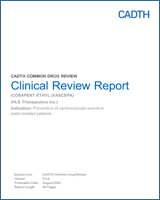| Designs and populations | Study design | DB placebo-controlled RCT | DB placebo-controlled RCT |
|---|
| Locations | US, Netherlands, Ukraine, Russian Federation, South Africa, Poland, India, Canada, Romania, Australia, and New Zealand | US (97 sites) |
|---|
| Randomized (N) | 8,179 | 702 |
|---|
| Inclusion criteria | Men or women ≥ 45 years old with established CVD or age ≥ 50 years with DM in combination with 1 additional risk factor for CVD Fasting TG ≥ 1.7 mmol/L (150 mg/dL) and < 5.6 mmol/L (500 mg/dL) LDL-c > 1.0 mmol/L (40 mg/dL) and < 2.6 mmol/L (100 mg/dL) and on stable statin therapy
| Men or women > 18 years of age with BMI ≤ 45 kg/m2 with high fasting TG levels (≥ 2.3 mmol/L [200 mg/dL] and < 5.6 mmol/L [500 mg/dL]), a stable dose of statin therapy (with or without ezetimibe), and at high risk for CVD. High risk for CVD was defined as clinical CHD or clinical CHD risk equivalents (10-year risk ≥ 20%), as defined in the NCEP ATP III guidelines; i.e., when one of the following were present: history of coronary artery disease (MI, angina, coronary procedure), atherosclerotic disease (e.g., PAD, TIA, carotid obstruction) Using atorvastatin, rosuvastatin, or simvastatin at optimal doses; patients had an LDL-c ≥ 1.0 mmol/L (40 mg/dL) and ≤ 3.0 mmol/L (115 mg/dL)
|
|---|
| Exclusion criteria | Severe heart failure Active liver disease Pregnant, breastfeeding, or plans for pregnancy Planned coronary intervention
| BMI > 45 kg/m2 or weight change > 3 kg from the first visit to the end of the qualifying period Use of other non-study, lipid-altering medication, or other statin not stated in the protocol Hemoglobin A1C > 9.5% after visit 1 Percutaneous coronary intervention within 4 weeks before screening Hospitalization within 4 weeks before screening Known nephrotic proteinuria Other major conditions (e.g., liver failure)
|
|---|
| Drugs | Intervention | Icosapent ethyl: 2 capsules of 1 g twice a day (4 g per day) p.o. | Icosapent ethyl (2 g per day): 1 g capsule (plus 1 placebo capsule) twice a day p.o. Icosapent ethyl (4 g per day): 2 capsules of 1 g twice a day p.o. |
|---|
| Comparator(s) | Placebo twice a day (4 capsules daily p.o.) | Placebo twice a day (4 capsules daily p.o.) |
|---|
| Duration | Phase | | |
|---|
| Run-in | Approximately 40 days | 6 to 9 weeks |
|---|
| Double-blind | Up to 6.2 years | Through follow-up (12 weeks) |
|---|
| Follow-up | Up to 6.2 (median 4.9) years | 12 weeks |
|---|
| Outcomes | Primary end points | First time to occurrence of any component of the composite of the following major adverse CV events:
CV death non-fatal MI (including silent MI) non-fatal stroke coronary revascularization unstable angina determined to be caused by myocardial ischemia by invasive/non-invasive testing and requiring emergent hospitalization
| Percent change in TG levels from baseline to week 12 |
|---|
| Secondary and exploratory end points | Composite of CV death or non-fatal MI (including silent MI) Fatal or non-fatal MI (including silent MI) Non-elective coronary revascularization represented as the composite of emergent or urgent classifications CV death Unstable angina determined to be caused by myocardial ischemia by invasive/non-invasive testing and requiring emergent hospitalization Fatal or non-fatal stroke Composite of total mortality, non-fatal MI (including silent MI), or non-fatal stroke Total mortality
| Percent changes in LDL-c, non-HDL-c, VLDL-c, Lp-PLA2, and apo B from baseline to week 12 end point Safety assessments included adverse events, clinical laboratory measurements (chemistry, hematology, and urinalysis), 12-lead electrocardiograms, weight, and BMI, vital signs, and physical examinations
Exploratory efficacy variables:
|
|---|
| Notes | Publications | Bhatt et al. (2019)25 | Ballantyne et al. (2012)26 Bays et al. (2013)27 Ballantyne et al. (2015)28 |
|---|
